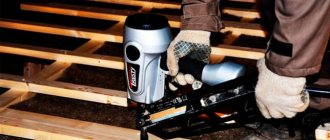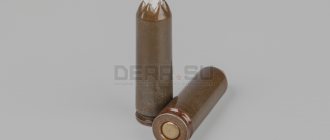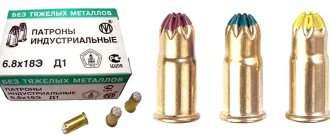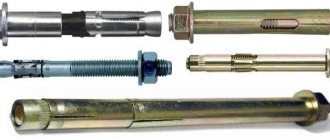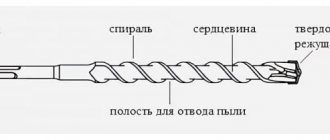Installing anything with this equipment is much faster than with a hammer drill
If you are a professional installer of, for example, drywall, and have become acutely aware that you want to increase your momentum, do more and better, then it’s time to think about updating your tool fleet. Today we will discuss a concrete mounting gun - its types, advantages and disadvantages, and also consider the most popular models on the market. Let's go!
Scope of application
Other applications for the tool include:
- construction of a wooden frame;
- flooring;
- fastening shelves, brackets, beams;
- covering surfaces with clapboard and much more. etc.
Mounting guns are available with different power sources. If there are no communications in the work area, a battery model is used. For long-term operation, options are being considered: electric, pneumatic and others that speed up the process of driving hardware.
You can use a nail gun on more than just wood. The tool copes with cardboard, parquet and other materials. There are models designed for concrete, roofing, and metal.
According to the scope of application, the models are divided into the following types:
| Name | Peculiarities |
| roofing | nails with large heads 25-50 mm long are placed in the drum |
| finishing | devices are equipped with cassettes into which thin nails without heads are loaded |
| frame | Capable of driving nails up to 220 mm long |
| cladding | designs work with standard hardware (25-75 mm) |
| for drywall | the length of hardware varies from 30 to 50 mm |
| parquet | the devices are equipped with rollers and an L-shaped pin; fasteners are driven in at a certain angle |
The structure consists of the following components:
- body – made of impact-resistant material;
- handle – has an ergonomic shape, the grip area is rubberized;
- trigger – located on the handle, which facilitates the control process;
- cassette or drum - fasteners are placed into the part;
- piston with compressed air - drives hardware under a pressure of 4-6 atm.
The operating principle of the tool is based on turning on the power and turning on the “Start” button. When the trigger is pulled, the piston is engaged. Under the influence of strong pressure, a powerful air stream emerges from it through the handle, which accelerates the hardware. At high speed, the fastener penetrates into the structure of wood or other material, thereby securing the part.
Popular models
The GFT-307 powder piston gun is used with 5.6x16 mm cartridges and can drive dowels up to 76 mm long and 8 mm in diameter. Replacing the piston is required after 1500 shots, cleaning the device after 1000. The weight of the device is 1.85 kg. When the chamber is opened, a semi-automatic ejection of the spent cartridge occurs. There is blocking from an unplanned shot. The screen (stop) provides protection from flying particles of material and ricochet. Model price 6500 rub.
The Spit P370 multi-charge mounting device is suitable for all types of mounting. It has low recoil, a good rate of fire, and the ability to adjust the shot energy. There is a large selection of materials to use. The weight of the device with the magazine is 3.2 kg, without it - 2.8 kg. The pressing force for the shot is 17 kg. Suitable for working with steel and concrete. Can hammer up to 700 nails per hour. Price - 46,700 rub.
Criterias of choice
Among the wide range and variety of models, it is difficult not to go wrong with the purchase of a nail gun. You can purchase the most convenient and high-quality tool, taking into account the following criteria.
Manufacturer
The quality of work on installing fasteners depends on the functionality and technical characteristics of the mounting gun. More reliable products are produced by well-known brands that value their reputation. Therefore, when purchasing a tool, you should consider nailers from the following manufacturers:
- BOSCH;
- RedVerg;
- Bison;
- DeWALT;
- PATRIOT;
- FoxWeld;
- RYOBI;
- Makita.
New technologies
A nailer has recently appeared in Russian stores, using the force of compressed nitrogen enclosed in a pneumatic cylinder to strike. The piston is driven by an electric motor powered by a battery.
This miracle of technology is called Senco Fusion F-18. Its advantages are already known:
- high rate of fire (3 shots per second);
- full mobility;
- cheap shot;
- battery charge for 500 shots;
- power of an average pneumatic nail gun.
Of the shortcomings of this pin hammer, only one is known so far - its cost is 35 thousand rubles, which makes its presence in the home workshop quite dubious.
We recommend other articles on the topic
Hand router for wood, accessories for hand router
Hydraulic jack - its design and principle of operation
Electric reciprocating saw - features of selection and use
Jigsaw machine - do-it-yourself options
What types of nailers are there?
Mechanical (manual) stapler - used mainly when assembling upholstered furniture for fastening upholstery fabric and film to a wooden surface. They are divided into two types: hammer and lever.
Mechanical lever stapler STAYER 31501
Mechanical hammer stapler STANLEY 0-PHT350
The hammer operates due to the inertia of the shock wave, which makes it similar to the operation of a hammer. The popularity of this model is small due to the need for scope and the lack of accuracy in hitting certain points. The advantage of hammer staplers is the speed of supply of staples, the disadvantage is the quality of fastening.
The lever stapler received more recognition. Its body contains a spring and a trigger mechanism. The spring is acted upon by pressing a lever.
Let's take an example of the characteristics:
Staple nailer STANLEY Light Duty 6-TR150L
Buy on Yandex Market
| Peculiarities | impact force adjustment |
| Type of mechanical stapler | lever |
| Housing material | metal |
| Type of equipment | nails/staples |
| Min/max nail length | 12/15 mm |
| Min/max staple length | 6/14 mm |
| Nail size | 300 |
| Standard size | 53 |
| Peculiarities | for type “A” staples (6, 8, 10, 12, 14 mm) and type “J” studs (12, 15 mm); cast aluminum housing |
| average price | 1610 rub. |
Gas nailing gun Toua GSN50E
Gas nailing guns - used for fastening various elements to concrete, iron, and wood using dowel nails. There is a clear advantage here that you do not need to drill a hole in the same wall in order to secure the element with a dowel-nail.
| Characteristics of the gas nail gun Toua GSN50E | |
| Power supply | gas |
| Magazine capacity (nails) | 30 pcs. |
| Store type | rack and pinion |
| Maximum impact force | 100 J |
| Min/max nail length | 15/40 mm |
| Battery | lithium-ion, voltage 7.2 V, capacity 1.5 Ah, 2 batteries included, |
| Number of shots per battery | 4000 pcs. |
| Number of shots per cylinder | 1400 pcs. |
| average price | RUB 31,800 |
Pneumatic stapler Fubag N90 rack type
Drum-type nailer CN80R
Pneumatic nailer - mainly used for roofing, available in drum and rack types. Shows good productivity of 3-5 nails per second depending on the model. To operate, you need a compressor, hoses and other accessories.
Powder mounting gun - used for driving dowel-nails into hard materials such as steel, brick, concrete. Its advantages are that no additional equipment is needed; powder cartridges and nails are used for charging. They can also be divided into single-shot and multi-shot, where the first one loads each cartridge manually; for the second option, a built-in cassette is used.
| Characteristics of the Gefest GFT603 powder nailer | |
| Power supply | gunpowder |
| Performance | 4.16 beats/min |
| Maximum impact force | 458 J |
| Housing material | metal |
| Type of equipment | dowel-nails |
| Min/max nail length | 15/72 mm |
| Equipment | case |
| Weight | 3.5 kg |
Equipment. Nailers are produced that work on one or several types of fasteners. The following are used as connectors:
- staples;
- nails;
- hairpins;
- nails/staples.
When choosing a tool, it is important to familiarize yourself with what types of equipment it can work with. In addition, you need to specify the type of nails or staples.
Additional functions
Maximum impact force, J. Pneumatic nailers are considered more powerful. Their impact force reaches 100 J. Gas models are no less strong (on average 85 J). Among corded and cordless nailers, there are devices with similar impact force indicators (80-100 J). Some household mounting guns have a rating of 5 J.
Productivity, beats/min. Professional and household models of nailers are produced. In the first case, the devices are distinguished by high power, maximum functionality and high wear resistance. Household models have a wide range of technical parameters, including performance.
This parameter corresponds to the maximum operating speed. Rate of fire is measured in the frequency of strikes per minute. Household models have rates up to 20-30 beats/min, professional ones – 60-120 beats/min. And this is not the limit.
Length of nails. When choosing a particular gun model, it is important to study what fasteners the device can work with - the minimum and maximum lengths of nails. Common models are capable of driving hardware from 10 to 90 mm in length. The larger the range of this parameter, the wider the scope of application of the tool.
Case material. The body of the product is subjected to mechanical stress, so it is made of durable materials. It can be impact-resistant plastic or metal. Some pistols have rubberized areas in the grip area. This solution prevents slipping.
Distinctive abilities. When developing new models, manufacturers try to equip them with additional options to expand the functionality of the tool and make it more convenient to use. Among the possible abilities of nailers:
- impact force adjustment;
- staple replacement indicator;
- rubber handle;
- trigger blocking;
- work area lighting;
- hook for hanging.
What is included
They often go on sale without equipment, and also complete with the following items:
- case;
- bag;
- oil;
- set of staples/nails;
- protective glasses.
Powder mounting guns (nailers)
The principle of their operation is very close to the principle of operation of firearms, only in weapons the powder gases push out a bullet or projectile, and in nailers they push a piston that drives a nail or dowel into almost any material used in construction.
First, about the advantages:
- small dimensions and weight;
- high impact force (up to 350 - 550 J), allowing the so-called. direct installation, which does not require preliminary preparation of the materials to be joined;
- impact force adjustment;
- high mobility;
- ease of maintenance and self-repair.
This tool is most often called a dowel gun. It is loaded with both mounting material and a special cartridge. For various not only targeted materials, but also materials for which shooting is carried out, there are different types of cartridges, marked with appropriate paint.
Also, the pistols themselves can be single-shot, when 1 cartridge and 1 dowel are inserted for each shooting.
They can also be multi-charged, when cartridges are fed automatically from a plastic clip, and fasteners from a cassette are fed in one movement.
Together with the adjustment on the pistol itself, you can ideally select the characteristics of the connection, but in any case, preliminary zeroing will be required. These guns work with different types of fasteners.
Along with the undoubted advantages, powder construction guns for dowels also have quite significant disadvantages:
- difficulty in use due to the inclusion of cartridges of different power and fasteners for various materials;
- restrictions on work in flammable environments and unventilated areas;
- high cost of fasteners;
- greater frequency of maintenance and replacement of wear parts;
- the need for permission to use this almost firearm-like instrument;
- the need to use both hands when working.
And who will not be confused by the listed disadvantages and the price from 5,000 rubles. for a simple powder pistol, and also:
- packaging of cartridges (50 pcs. at a price of 300 rubles);
- packaging of dowels (on average 40 rubles for 15 pcs.),
then, when using it for home purposes, hardly anyone will ask whether you have a special permit.
But decide for yourself whether you need such a tool in your everyday life.
How to use it correctly
It is easy to work with a mains or battery model. When the tool is disconnected from the network, nails or other hardware are loaded into the drum. The impact force is adjusted taking into account the type of material and the length of the fasteners. After connecting the cable to the outlet, just place the tool in the desired location and pull the trigger.
When working, it is recommended to adhere to the following rules:
- Use only serviceable and certified tools.
- Before starting installation, wear protective clothing and safety glasses with side guards.
- When choosing powerful models, you need to wear earplugs or headphones, as some devices make a lot of noise when driving nails.
- Before starting the device, you should check the reliability of the connections of all structural parts. Attention is also paid to the quantity of hardware in the store. To start working, you need to put the nailer on its side and charge the clip, then close the lid.
- Don’t forget about adjusting the depth of driving nails; you need to adjust it before work.
- Sparks may fly out of the gun during operation. To maintain fire safety, it is recommended to remove flammable objects from the work area.
- During operation, it is necessary to monitor the rotation of the spring mechanism. After each blow it must return to its original position.
- The tool is positioned strictly in the direction of the surface being processed.
- After installation is completed, the magazine is emptied, the body is wiped with a dry cloth, after which the gun is placed in a case or box. It should be stored in a cool but dry place. To extend the service life of the tool, it is recommended to lubricate the holes after each use with machine oil.
Pneumatic mounting guns
This is where engineering thought flourished on a special scale. The shapes, designs and dimensions of pneumatic nailers are many times larger than previous types of this tool.
These include small staplers for the furniture industry, which are successfully used by home craftsmen for upholstering furniture and finishers for fastening various wall panels, and fairly large and powerful nailers, working on construction sites and in the workshops of large enterprises.
Most of the models that are interesting to have in a home workshop are designed for standard parameters of household compressors with a pressure of 6 - 8 bar and a receiver capacity of 24 to 50 liters.
This is definitely the most convenient tool for organizing some kind of mini-production at home using staples, nails or similar fasteners. A separate item in this section can be awarded to the Japanese nailer-screwdriver from MAX. It simultaneously hammers and screws in fasteners, reminiscent of a self-tapping screw, and is designed for super-fast installation of drywall. It works in tandem with a tool for installing plasterboard metal profiles and allows you to speed up the process tenfold.
Also of particular interest to home craftsmen may be such a rather exotic tool in the huge family of pneumatic mounting guns as a palm nailer.
Despite its apparent flimsiness and size, it can easily handle nails up to 100 mm in length with a thickness of 3.5 - 4.5 mm, with heads up to 10 mm in diameter.
The main advantages of pneumatic nailers are:
- simplicity and reliability of design;
- the highest operating speed (up to 3 shots per second);
- sufficient power even for small models;
- light weight;
- Possibility of use in rooms where the use of powder and gas nailers is prohibited;
- low cost per shot;
- lack of permits, etc.
This type of nailer has the fewest disadvantages. The main ones are:
- attachment to a source of compressed air;
- need for electricity.
True, some manufacturers solve the latter by equipping the compressor with a powerful battery, but it also adds significant weight to the entire installation.
Types of nails for nail guns
Smooth nail
Ring knurled (Ruffy)
Screw
Roofing drum nails
According to their application, nails can be divided into several types:
| Smooth | The most popular nails are used mainly for various wooden containers and pallets. The advantages include the low price; they can be easily incorporated into any wood. |
| With ring knurling (brushed) | With ring grooves throughout the shaft, it has high holding capacity and low price. |
| Screw | With knurling in a spiral, it penetrates more easily into the structure of the wood and does not put much stress on the tool, thereby extending its service life. |
| Roofing | A separate type of nails for drum pneumatic nailing gun. They have a design feature in the form of a wide nail head; they press the soft roof well. |

